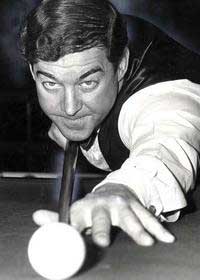Eddie Charlton
 | |
| Born |
31 October 1929 Merewether, New South Wales, Australia |
|---|---|
| Died |
8 November 2004 (aged 75) Palmerston North, New Zealand |
| Sport country |
|
| Nickname | Steady Eddie, "wobbly Edward" |
| Professional | 1963–1995 |
| Highest ranking | 3 (1976–1981) |
| Career winnings | £322,933[1] |
| Highest break | 138 (1978 Australian Professional Championship) |
| Century breaks | 46[2] |
| Best ranking finish | Final (1975 World Championship) |
| Tournament wins | |
| Major |
Australian Professional Championship: 20 (1964-84) World Professional Match-play Championship (1976) |
| Non-ranking | 28 |
Edward Francis "Eddie" Charlton, AM (31 October 1929 – 8 November 2004) was an Australian professional snooker and English billiards player. He remains the only player to have been world championship runner-up in both snooker and billiards without winning either title. He later became a successful marketeer of sporting goods launching a popular brand of billiard room equipment bearing his name.
Early life
Charlton was born in Merewether, New South Wales, Australia and came from a sporting family. His brother Jim was also a professional snooker player but never joined the world ranks. Eddie himself was also a senior grade footballer, a champion surfer, a good cricketer and a boxer. One of his proudest moments was when he carried the Olympic torch on part of its journey to the 1956 Games in Melbourne.
He worked for a short while as a coal miner before deciding to become a professional cue sports player on the advice of Fred Davis.
Career
Charlton became a professional player in 1963 at the age of 34. The following season he won his first Australian Professional Championship. For the next 20 years, with one exception, he won the title annually. He unsuccessfully challenged Rex Williams for the World Billiards Championship title in 1974 and 1976. His third appearance was in 1984 when he lost by a handful of points to Mark Wildman. Four years later he lost to two-time champion Norman Dagley in his last World Billiards final.
Charlton was also the most successful Australian snooker player until the emergence of Neil Robertson. From the first year of the rankings in 1976/77, he was ranked number three in the world for the next five consecutive seasons from although he never won a ranking tournament (because in the early years only the Snooker World Championship counted).
Charlton, who was known for his focused and dogged performances, challenged for the Snooker World Championship in 1968 and was the runner up in the final of Snooker World Championship in 1973 and 1975. In his last appearance in 1975, he lost by just one frame (31–30) to Ray Reardon. However his 1972, 1973, and 1980 victories in the BBC's Pot Black competition gave him a high profile with television audiences. He also recorded the first century break (110) on Pot Black, a one-frame per match format.
Charlton was known for playing with a very straight cue action and rarely hitting the ball with any sidespin.[3]
Although he did not reach the final stages of the World Championship in his later career, Charlton continued to perform at a competitive level. His last major achievement was his 10-9 win over Cliff Thorburn at the 1989 World Championship.
Tournament Wins
Non-Ranking Wins: (28)
- Australian Professional Championship - 1964-1984 (20 Times)
- World Open Snooker Championship - 1968
- World Professional Match-play Championship - 1976
- Pot Black - 1972,1973,1980
- Limosin International -1979
- Kronenbrau 1308 Classic - 1979
- Australasian Championship - 1969
Personal life
Always active in the organisation and promotion of the game, Charlton was awarded the Order of Australia in 1980. He formed the Australian Professional Players Association and was responsible for bringing many of the top players to play in Australia. He made his final appearance at the Crucible in 1992 where he was defeated 10–0 by defending champion John Parrott, the only recorded whitewash in the history of the World Championship. He released a 30-minute beginners' instructional video, Eddie Charlton's Snooker, Pool & Trick Shots, in PAL VHS format. He stopped competing in 1995 and died in Palmerston North, New Zealand on 7 November 2004 following an operation.[4]
Performance timeline
| Tournament | 1970/ 1971 | 1971/ 1972 | 1972/ 1973 | 1973/ 1974 | 1974/ 1975 | 1975/ 1976 | 1976/ 1977 | 1977/ 1978 | 1978/ 1979 | 1979/ 1980 | 1980/ 1981 | 1981/ 1982 | 1982/ 1983 | 1983/ 1984 | 1984/ 1985 | 1985/ 1986 | 1986/ 1987 | 1987/ 1988 | 1988/ 1989 | 1989/ 1990 | 1990/ 1991 | 1991/ 1992 |
|---|---|---|---|---|---|---|---|---|---|---|---|---|---|---|---|---|---|---|---|---|---|---|
| World Championship | SF | SF | F | 2R | F | SF | QF | SF | SF | QF | 2R | SF | QF | 2R | 2R | 2R | LQ | 2R | 2R | 1R | 1R | 1R |
| Performance Table Legend | |||
|---|---|---|---|
| LQ | Failed to qualify | #R | Lost in the early rounds |
| QF | Lost in the quarter-finals | SF | Lost in the semi-finals |
| F | Lost in the final | W | Tournament winner |
| A | Did not participate in the tournament | NH | Tournament was not held |
References
- ↑ http://cuetracker.net/Players/Eddie-Charlton/Career-Total-Statistics
- ↑ http://cuetracker.net/Players/Eddie-Charlton/Career-Total-Statistics
- ↑ "Obituary: Eddie Charlton". The Guardian. 9 November 2004. Retrieved 28 January 2015.
- ↑ "Eddie 'Mr Snooker' Charlton dies, 75". The Age. 20 November 2004.